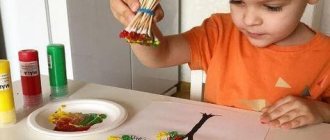Preschool age is special. At this time, cardinal changes occur in the child’s behavior and psyche, his abilities are revealed, and the foundation for future successes and achievements is laid. It is not surprising that attentive parents try to make every effort for the development of their baby. And often they are faced with the question: what and how to develop? Abstract-logical thinking is considered the highest form of thinking, and it affects the success of learning at school. But is there any point in developing it at 4-5 years old? Is not it too early? Before answering this question, let's first understand the peculiarities of a preschooler's thinking.
The thinking of a 4–6 year old child: what is it like?
Mental activity is the ability to establish connections and relationships between phenomena and objects and draw conclusions. And it does not exist separately from the psyche as a whole, but is connected with all the processes that occur in the baby’s mind. And there are many of them, because at this age a child discovers and learns about the world.
Fundamentals of mental activity of a preschooler. Prerequisites for abstract-logical thinking
Speech
Perhaps the most fundamental role in the mental development of a preschooler is played by comprehension of the art of speech or, as psychologists say, the sign function of consciousness. Words-signs are the most important tools of thinking. And the better the baby speaks, the more successful the development of his thinking will be.
And the point here is not only in vocabulary, but also in mastering the entire grammatical structure of speech. Thus, knowledge about the genders of nouns is associated with:
- the most complex analysis of a wide variety of information;
- understanding the connections and relationships of living beings;
- transfer of certain characteristics (kind) from one object to another, including from living to inanimate.
And this requires abstract thinking. Knowledge and use of definitions, additions and circumstances, complication of sentences makes not only speech, but also thinking richer.
Perception
Any information about the external world is material for thinking, and the channel through which this information enters the brain is perception. At preschool age, children are already more attentive, they are able to consciously concentrate, and they are interested in many things in the world around them:
- enjoy looking at flowers and clouds floating across the sky;
- notice a change in leaf color in the fall;
- love to watch kittens and puppies, butterflies and birds;
- listen to music with interest;
- they taste things that are sometimes inedible from the point of view of adults.
Kids actively accumulate material to develop their thinking. Of great importance is their need to connect speech to the process of cognition, to give “names” to everything they see and feel, to describe, to tell. Often children do not have enough words for this, and they turn to adults who must help. The designation of things and phenomena, objects and actions is a significative function of speech; it is very important for the development of thinking, first of all, conceptual, abstract-logical.
Mastering sensory standards
In preschool age, an important role is played by understanding sensory standards, that is, ideas formed in society about the characteristics of things, their properties, and relationships. The simplest sensory standards include:
- geometric figures,
- colors,
- temperature characteristics,
- sizes, etc.
Understanding and operating with sensory standards (distinguishing colors, geometric shapes, comparative characteristics of sizes and weights, etc.) is a very important prerequisite for the development of abstract logical thinking. Thus, understanding that the sun drawn in the picture is round and the house is square requires preliminary complex mental work: analysis, comparison, highlighting the characteristics of the standard (circle or square), abstracting (separating) this characteristic and transferring it to another object.
It is also important that the standards are interconnected by complex relationships, the understanding of which is an important step in the development of children’s abstract thinking. For example, pyramid rings can be put on a stick, but circles cannot; a triangular roof can stand on a square house, but not on a round ball.
Mastery of subject activity
This is another important prerequisite for the development of thinking. Children don't just play with objects, they study their properties and features. Until the age of 4, a child’s thinking occurs primarily in objective activities, in the process of games, and manipulation of things. In early childhood, only visual and effective thinking is possible in children. And when they do not play with objects, there is no mental activity.
There is one more important point. In the process of evolution, it turned out that hands are of fundamental importance for humans, therefore, on the palms and fingertips there are a huge number of points associated with different parts of the brain. As psychologists say, by training fine motor skills of the hands, the child develops the brain.
In preschool age, children love to do everything with their hands:
- molded from plasticine, dough and mud;
- draw on paper and walls;
- They enthusiastically collect Legos.
Their hand movements become more precise, coordinated, and with them their thinking becomes more developed and complex.
All these changes are important prerequisites for the complication of mental activity; visual-effective thinking is replaced by figurative thinking - more complex and already abstract thinking.
In the world of images
Images occupy the main place in the thinking of children of this age; in fact, they perform the function of signs, the role of which will later be played by words. The speech form of thinking also exists, but it is not yet independent and is subordinate to images, depends on them and is determined by them. That’s why children love bright pictures so much and enjoy drawing. Some psychologists even believe that drawing partly replaces abstract thinking in children and creates the basis for it. Therefore, visual arts activities greatly contribute to the development of children's thinking.
- Unlike visual-effective thinking, imaginative thinking already allows you to be distracted from a specific situation and even fantasize. At this age, the imagination is so bright and vivid that, with the weakness of rational thinking, children sometimes mistake the images of their imagination for real beings. Remember "Carlson, who lives on the roof." This is a completely realistic story about a boy and his imaginary friend.
- Images are involved in all mental operations, and for the child they are still more important than abstract concepts. But children are already able to understand schematic images, for example, a circle, an oval and four sticks for it depicted on a piece of paper will be unmistakably called a man. And if you explain to them what a plan is, then they enthusiastically begin to draw a house plan and “place” furniture, doors, windows, and toys in it.
At preschool age, children are able to solve quite complex logical problems, however, if they can operate with images. For example, when listening to a fairy tale about Kolobok, they unmistakably come to the conclusion that it was his own fault that Kolobok was eaten - there was no need to run away from his grandparents. True, they cannot yet bring the fairy tale to a different logical conclusion - because otherwise Kolobok would have been eaten by his grandparents.
Using images, children successfully cope with all logical operations:
- analysis,
- comparison,
- comparison,
- synthesis.
We can say that imaginative thinking itself contains the prerequisites for mastering logical thinking. And by the end of preschool age, these two types of thinking coexist perfectly and complement each other.
Games
Logical thinking games for preschoolers
If you've ever tried to reason with a three-year-old, you know that a child at that age doesn't think logically. Young children are very concrete and literal in their thinking, and only as they approach school age do they begin to demonstrate a readiness for tasks that require more abstract thinking. However, preschoolers often make surprising connections as they explore and make sense of the world, and there are several fun logic games that will answer your child's question: What is logic?
How to help your child develop logical thinking
Of course, abstract logical thinking needs to be developed. But we shouldn’t forget that the figurative is also very important:
- Firstly, this is the basis of creativity; you need to treat imaginative thinking very carefully and not interfere with children’s imagination, but on the contrary, develop their imagination in every possible way.
- Secondly, psychologists associate the active process of development of abstract logical thinking with primary school age.
Therefore, you should not rush and put the cart before the horse - the child’s psyche is not yet ready for full-fledged logical thinking. But the basis for it, the prerequisites for further successful development, are really needed.
What should be developed
The main tools of logical thinking: words-concepts and verbal structures - judgments and inferences. Therefore, the development of the sign function of consciousness, that is, speech, must be taken as seriously as possible.
- When working with a child, you should pay attention to both the volume of vocabulary and understanding the meaning of the words that the child uses.
- The construction of sentences is also important. Compound and complex sentences are forms of logical thinking in which connections and interdependencies between objects, a sequence of actions, etc. are established. Therefore, it is necessary to help the child construct and use complex sentences in speech.
- At this age, the child uses speech, pronouncing his actions and reasoning while playing and drawing. Such speech is only an addition to figurative thinking, but it can gradually be turned into a full-fledged one, inviting the child to tell what he is doing.
The word is not yet an unconditional tool of thinking, so it is important to organize play activities so that the child actively uses speech and learns to use words not only in external, but also in internal speech.
The next direction in the development of logical thinking is the child’s assimilation of abstract concepts, that is, the meanings and meanings of words that are not associated with specific sensory images. The simplest of these concepts are sensory standards; they are easier for a child to understand, because there is still an attachment to specific objects. More complex concepts for a child are:
- joy;
- justice;
- holiday;
- game, etc.
Abstract concepts of logical thinking include signs, such as road signs and numbers. Mathematical operations with them are very useful for the development of a higher form of thinking. As a rule, children in older preschool age can already perform simple arithmetic operations, but they do them based on an image, for example, counting cars, apples, bunnies.
Mastering at the elementary level the basic forms of logical thinking (analysis, comparison, synthesis) is also quite accessible to children of this age. For example, establishing cause-and-effect relationships.
Kids love to ask: “Why?” And adults should not just answer the child’s questions, but invite him to reason and find the answer on his own. Even if this answer is not entirely factually correct, it is important that it is logical. For example, to the question: “Why is there wind outside?” a child may say: “Because the branches of the trees sway strongly, they disperse the air and it turns out to be wind.” In fact, this is an incorrect answer, but it is quite logical within the framework of the child’s existing knowledge. And he should be praised for such an answer, but given the correct one.
How to better develop logical thinking
The development of a child is a very delicate process, especially when it comes to his psyche. Therefore, there are 3 basic rules that should be followed:
- The formation of logical thinking should take place in the form of play, since at this age play is the leading activity.
- The game should be collaborative. The more actively the adult interacts with the child, the more effective the development will be.
- Developmental activities will only be beneficial if the child enjoys them.
Therefore, it is worth showing creativity and ingenuity, inventing and organizing exciting games. And if you can’t come up with something, then you can use ready-made exercises. There are quite a lot of them on the Internet. And we offer you a few as an example.
Exercises to develop logical thinking in preschoolers
Speech development exercise “Making a fairy tale”
Children enjoy making up stories about their favorite toys and pets. But they do it together with adults. It is the adult who should be the initiator, invite the child to choose a character and come up with his adventures.
Initially, it is difficult for a child to find a suitable plot, so an adult should help by starting sentences and asking leading questions. For example, like this:
– One morning the kitten Murzik went for a walk... Where?
- What happened next? He probably met...
- Who? What did they do? Etc.
Such exercises not only develop speech and the ability to build sequence and logic of events, but also the child’s imagination.
Word games
You can come up with a lot of games with words, using existing knowledge and supplementing it with new ones. Knowledge of the names of colors and the transfer of color characteristics to objects can be practiced in the game: “What color lives in the kitchen?” Ask your child to name objects, for example, that are red or brown in your kitchen.
You can search for objects with a specific letter or those with a hidden number. For example, a chair, a dog, a pillow, etc. have the number four.
Exercise “What does it look like”
Show your child geometric shapes (circle, triangle, square) and ask him to say what they look like. You can also suggest finishing these figures. For example, make a bun or a sun out of a circle, or a house or a gnome’s hat out of a triangle and square. You may have to do the first drawings yourself, but children will be happy to join this game once they understand what is required.
The same exercise can be done in reverse. Invite the child to say what shape a ball, pancake, book, cat's ear, etc. looks like.
Exercise "Pathfinder"
For it, you will need to draw different traces on a sheet of paper: a person, animals, birds. Then ask the child: “Who walked through this snowy clearing?” You can even complicate the exercise by introducing a task to find a logical inconsistency. Draw traces of bare human feet in the “snow” and ask the child: “What’s wrong, wrong?” If he guesses that no one walks barefoot in the snow, then it means that things are going well with the development of his logical thinking.
You can create similar exercises and games yourself, or even better, after doing various exercises with your baby, invite him to come up with a task for mom or dad.
Any of these exercises develops a whole complex of mental processes. In addition to logical thinking, speech, imagination, objective activity, and imaginative thinking are activated in them. And just as important, children learn to solve problems together with adults; they see their parents not only as elders with power, but also as their partners and friends. And how important this is will become clear when your children are teenagers.
What does logic use?
What is logical thinking and what basic concepts does logic use?
Logical thinking is thinking that involves reasoning and using what you know to draw conclusions. Logical thinking is the basis of cognition. This requires an understanding of attributes, relationships and sequencing, and is not only important for formal learning; it is a necessary life skill. Logic is, in simple words, the rational mental activity of a person. And logically it is consistent. Logical-reasonable.






